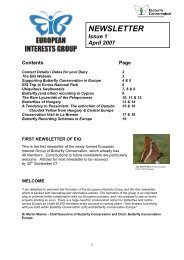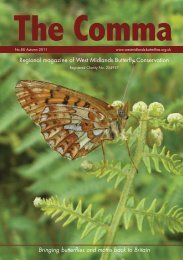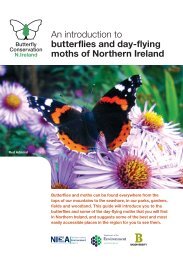Spring 2012 newsletter - Butterfly Conservation
Spring 2012 newsletter - Butterfly Conservation
Spring 2012 newsletter - Butterfly Conservation
You also want an ePaper? Increase the reach of your titles
YUMPU automatically turns print PDFs into web optimized ePapers that Google loves.
<strong>Spring</strong> Moths in Scotland Jan England<br />
Moths, Scotland & early April didn’t<br />
sound like an ideal combination at<br />
first glance. However, a friend and<br />
I set off by train to Pitlochry in an<br />
optimistic mood.<br />
Our course was held in the Field<br />
Studies Centre at Kindrogan, a<br />
former country mansion about<br />
ten miles outside Pitllochry. Set in<br />
extensive grounds with woods, river<br />
& moorland it offered a variety of<br />
habitats & spectacular scenery. We inspected<br />
the mothtraps after breakfast, had a coffee<br />
break halfway round the eight traps and set off<br />
before lunch to different sites to look for moths<br />
and butterflies. Each evening after slides and a<br />
discussion we tried to identify moths we had<br />
caught that morning. By the time that finished<br />
and the moths released we were all ready for a<br />
reviving drink in the bar!<br />
Target species for the week included Brindled<br />
Ochre, Rannoch Sprawler, Rannoch Brindled<br />
Beauty, Swordgrass & Orange Underwing.<br />
Finding these depended on the right weather<br />
conditions, no mean feat in a Scottish April.<br />
Despite some rain during one or two nights, each<br />
day was dry, sunny & unseasonably warm, 17-19<br />
degrees. Nights were mild too so<br />
this produced good results in the<br />
traps our tutor ran each night.<br />
By the end of the course we had<br />
recorded good catches of 26<br />
species in & around Kindrogan<br />
including Brindled Ochre, Early<br />
Toothed-striped, Oak Beauty,<br />
Swordgrass, Water Carpet, Satellite<br />
& Yellow Horned.<br />
Male Rannoch Brindled Beauty<br />
A female wingless Rannoch Brindled Beauty Photos by Jane Bowman<br />
12<br />
A trap was also run in birchwoods<br />
at Kincraig which produced 14<br />
species with the RDB moth Rannoch<br />
Sprawler found on birch trunks in<br />
the garden thanks to the diligent<br />
searching of 13 course members.<br />
The moth our tutor was most keen<br />
to find was the Rannoch Brindled<br />
Beauty a Nationally Scarce A moth<br />
which rests by day on fenceposts &<br />
walls.<br />
The male is small, has a black furry body with a<br />
line of orange dots along the abdomen,grey semitransparent<br />
wings marked with a dark curved<br />
outer cross line & central crescent.The female’s<br />
body is the same but she is wingless.These moths<br />
are usually found low down on fenceposts so our<br />
group presented a strange sight to passers-by as we<br />
peered, bent double, at dozens of posts along the<br />
road to Struan.The sharp-eyed amongst us finally<br />
found 8 males and 13 females after two days<br />
searching.Back to the bar again that night!<br />
Our final target species was a day-flying moth<br />
called Orange Underwing usually seen flying<br />
around the top branches of birch trees in<br />
sunshine.<br />
Fortunately the exceptionally warm sunny weather<br />
in Scotland meant we found Orange<br />
Underwings on three days with over 20<br />
being seen along the Old Military Road<br />
at Drumcroy Hill. Once more our group<br />
entertained passing traffic as we ran up &<br />
down desperately trying to net an Orange<br />
Underwing for detailed inspection.<br />
After a week of excellent mothing, good<br />
weather amid wonderful scenery we agreed<br />
our optimism had been well and truly<br />
rewarded.







